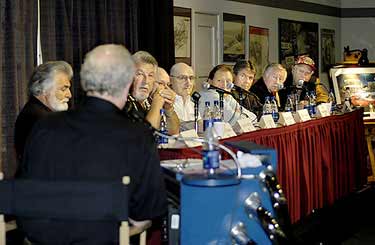|

5/7/04
“Outlaw”
Operators Hosted By Wally Parks And His Museum

Moderator Dave
McClelland (back to camera) introduced celebrity-panelists
Blackie (“Call Me Whitey!”) Gejeian,
Steve Gibbs, Chuck Griffith, C.J. Hart,
Harry Hibler, Mike Jones, Don Rackemann
and Lou Senter. Partially visible at far
right is James Ibusuki’s original painting
of “The Manufactuers Final”, a
lithograph (available from hotrodnostalgia.com)
celebrating Jones’s best-remembered
OCIR event. (Photo by Chris Ouellette/Good
Communications) |
 y
favorite NHRA events are presented by the “guerilla
wing of the organization, i.e., the small staff
of the Wally Parks Motorsports Museum. Located
on the grounds of the L.A. Fairplex, mere minutes
from corporate headquarters, the museum is operated
as if it’s on a different planet. That’s
not a bad thing. While the historically-challenged
outsiders in charge of the parent company continue
to come up with innovative ways to drive off
NHRA’s oldest, hardest-core racers and
fans, the savvy museum crew conceives nostalgia-flavored
shows that appeal to us “lost souls.” y
favorite NHRA events are presented by the “guerilla
wing of the organization, i.e., the small staff
of the Wally Parks Motorsports Museum. Located
on the grounds of the L.A. Fairplex, mere minutes
from corporate headquarters, the museum is operated
as if it’s on a different planet. That’s
not a bad thing. While the historically-challenged
outsiders in charge of the parent company continue
to come up with innovative ways to drive off
NHRA’s oldest, hardest-core racers and
fans, the savvy museum crew conceives nostalgia-flavored
shows that appeal to us “lost souls.”
The first such success was the NHRA California
Hot Rod Reunion at Bakersfield, the brainchild
of museum staffers Steve Gibbs and Greg Sharp.
In 12 years, its attendance has grown to rival
that of some NHRA national events. Another example
is the year-old National Hot Rod Reunion, an
immediate sensation in Bowling Green, Ky. Not
ADVERTISEMENT
 |
|
coincidentally,
both shows are staged at distinctive, decades-old
drag strips, which in no way resemble the sterile,
concrete-and-aluminum “’plexes”
that pollute the championship circuit.
Lesser known, but no less significant, is a
series of indoor presentations hosted at the
museum itself. So irresistible was the latest
such promotion that I found myself driving all
night—more than 400 miles—to make
a 10 a.m. gathering of former California track
operators, appropriately billed as “Drag
Strips We Knew And Loved (And The Men Who Ran
Them)”. As the sun came up beside Highway
99, I was reminded of countless early-morning
trips to the same Pomona property in the 1960s,
‘70s, ‘80s and early ‘90s, when
I wouldn’t have dreamed of missing opening
day of a Winternationals or World Finals. Sadly,
those days are long gone for me.
Irony was everywhere, beginning with a familiar
approach that took my dad and me along the full
length of the Pomona track, on a road that was
once recognizable to anyone who ever saw a top-end
photo. Alas, those towering cypress trees behind
every parachute shot have been harvested to
make room for more concrete. Upon arrival at
the museum, more irony was supplied by the odd
combination of panelists: former track operators
traditionally aligned with, and invariably opposed
to, the sanctioning body and its edicts. In
a program both hosted and promoted by NHRA,
the panel leaned heavily towards the latter,
“outlaw” element.

|